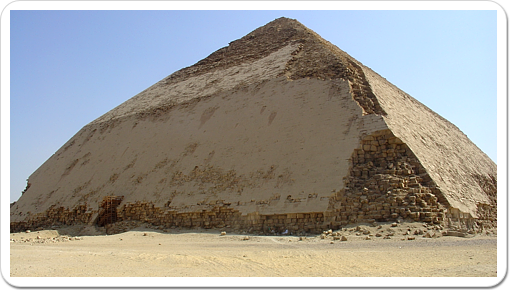Located to the southwest of Memphis at some 10 kilometres to the south of Saqqara and some 40 kilometres north of Meidum, Dashur is the most southern site of the Memphite necropolis, which stretches to Abu Rawash in the north.
On a clear day, the two pyramids built there by Snofru, the founder of the 4th Dynasty as well as the mountain-like remains of the pyramid of Amenemhat III can easily be seen from Saqqara to the north and Meidum to the south, or even from Egypt’s modern-day capital Cairo, which lies some 50 kilometres to the north.
Dashur owes its modern-day name to the nearby villages Dashur and Minsat Dashur. This name may perhaps come from the Coptic name Tahsur, or Takuris in Greek. The Ancient Egyptian name for this area may well be mentioned in the story of Sinuhe: wnt snfrw but it is not unlikely that the site may have had different names in antiquity as it was not uncommon to refer to an area by the name of one or more of its principal buildings.
This southernmost part of the Memphite necropolis stretches an area of approximately 3 to 3.5 kilometres from south to north and 2 to 2.5 kilometres east to west.
It starts at about 1.5 kilometres to the west of the fertile ground, although in the time the area was used as a necropolis, this may well have been different.

Interactive map of Dashur. Hover over the map and click or tap on the red circles to learn more.
Source: Lehner, Complete Pyramids, p. 101.
The history of this site is a somewhat shorter than the history of its northern neighbour, Saqqara. Archaeological research has revealed no traces of activity in this area before Snofru, which may mean that Snofru chose this area, among others, because it had not been used before. A similar motivation may have driven him to found the royal necropolis at Meidum, some 15 years earlier. It is, however, not known why he abandoned Meidum to favour a new virgin site. Some have speculated that Snofru wanted to be closer to the Nile Delta, but if that really were the case, one could wonder why he did not move to an even more northern site such as Giza or Abusir.
Perhaps the explanation might be found in the fact that at Dashur Snofru did not build a Step Pyramid, as he had done in Meidum, but a true pyramid. The shift from Step Pyramid to true pyramid represents a shift in ideology, turning from a royal tomb that represented a staircase to the stars to a monument that was both a solar symbol and a reference to the primeval mound from which all life had supposedly sprung.
The first pyramid was built in the Southwestern corner of the Dashur area, to the Northwest of a like and at quite some distance into the desert. This pyramid was started at an angle of 54°27'44", but about halfway, the angle was changed to 43°22'. This bend in the sides of the pyramid has given it its modern-day name: the Bent Pyramid.

Snofru’s Bent Pyramid, its characteristic shape the result of a decrease in angle about halfway up the monument, was the first pyramid built at Dashur.
Perhaps because the change of angle did not conform to the new ideology, Snofru started a second pyramid, at some distance to the north of the Bent Pyramid. This new pyramid is often called the Red Pyramid because of its reddish appearance. The west side of the Bent Pyramid roughly aligns with the east side of the Red Pyramid. The angle of the Red Pyramid is the same as the top part of the Bent Pyramid: 43°22’.
The small pyramid to the northeast of the Red Pyramid was never completed. Archaeological research has shown it to date to the 4th Dynasty as well, but it is not clear for whom it was built.
At about the same time, several private tombs were constructed to the east of the two pyramids. One of Snofru's sons, a man named Kanefer, was buried in one of the tombs closest to the Red Pyramid.
The first notable building activity in the area after Snofru is dated to the reign of Amenemhat II of the 12th Dynasty, who chose to build his pyramid near the cluster of Old Kingdom tombs where Kanefer was buried. His example would be followed by Sesostris III, who moved slightly to the north, and Amenemhat III, more to the south.
The Middle Kingdom pyramids at Dashur were built closer to the edge of fertile land. Amenemhat III abandoned his pyramid, probably because it was being built on unstable desert sand.
At least the Northern part of Dashur continued to be used as a necropolis for private burials during the New Kingdom. More research and archaeological fieldwork are needed to reveal the full history of the southernmost part of the Memphite necropolis.
After the Middle Kingdom, Dashur seems to have lost its appeal as a royal necropolis. Amenemhat III's pyramid was the last royal funerary monument that was built there. Recent archaeological research, however, has revealed a private necropolis dated to the New Kingdom at North Dashur.